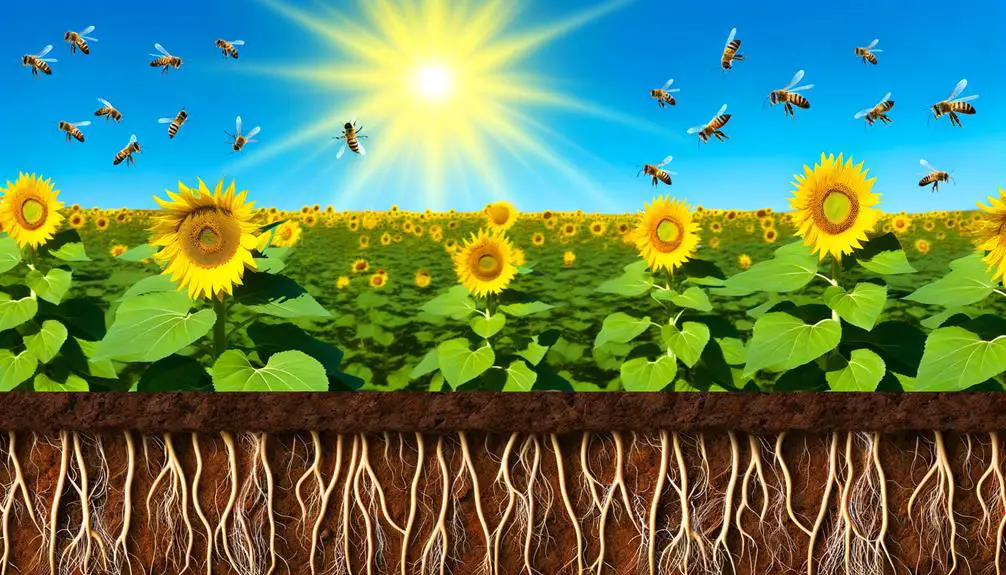How Do Sunflowers Symbolize Different Cultures?
The sunflower serves as a multifaceted symbol, representing adoration, loyalty, optimism, and positivity. Its heliotropic behavior underscores themes of fidelity and constancy, while its robust structure epitomizes resilience and perseverance.
Deep-rooted and vibrant, sunflowers are emblematic of spiritual enlightenment and healing. Nutritionally, sunflower seeds and oil provide essential nutrients, reflecting sustenance and growth.
Culturally, they're revered in diverse traditions, embodying faith and longevity. Psychologically, their bright appearance promotes happiness and reduces stress, enhancing psychological well-being.
Further exploration reveals additional compelling aspects of this remarkable botanical symbol.

Key Takeaways
- Sunflower symbolizes adoration and loyalty.
- It represents optimism, positivity, and happiness.
- The plant signifies resilience and perseverance.
- Sunflowers are associated with spirituality, faith, and healing.
- They evoke light, joy, and enlightenment in various cultures.
Adoration and Loyalty

The sunflower (Helianthus annuus) serves as a potent symbol of adoration and loyalty, rooted in its heliotropic nature and historical associations with unwavering devotion. Its heliotropism, the directional growth towards sunlight, symbolizes fidelity and constancy. This botanical phenomenon is a result of differential cell growth regulated by phytohormones like auxin.
Historically, sunflowers were revered by the Incas, who associated them with solar deities, signifying steadfastness and reverence. Contemporary studies in symbolic anthropology suggest that the sunflower's consistent orientation towards the sun mirrors human emotional steadfastness.
This convergence of botanical behavior and cultural symbolism underscores the sunflower's enduring representation of heartfelt loyalty and unwavering affection, embodying a natural phenomenon that parallels human expressions of devotion.
Resilience and Perseverance
Often considered a symbol of resilience and perseverance, the sunflower demonstrates impressive adaptive mechanisms that allow it to thrive in diverse and often challenging environments.
Helianthus annuus, the common sunflower, exhibits heliotropism—a diurnal motion that aligns its floral head towards the sun, optimizing photosynthetic efficiency. This physiological trait is essential for survival, especially in arid and nutrient-poor soils.
Additionally, sunflowers possess deep taproots that enable access to water reserves and essential minerals from subsoil layers. Studies indicate that their strong cellular structure and high lignin content provide resistance to various pathogens and pests.
These adaptive features highlight the sunflower's ability to withstand environmental stressors, embodying resilience and perseverance in the plant kingdom.
Optimism and Positivity

Sunflowers are emblematic of optimism and positivity, primarily due to their vibrant yellow petals and phototropic behavior, which symbolizes brightness and energy.
Botanical studies have demonstrated that sunflowers' heliotropic movements, following the sun across the sky, are indicative of growth and renewal.
This phenomenon is supported by research indicating that such movements optimize photosynthesis, thereby enhancing the plant's development and reinforcing its symbolic association with positive growth and strength.
Brightness and Energy
In the domain of symbolic interpretations, sunflowers are frequently associated with brightness and energy, embodying a sense of optimism and positivity that is often supported by empirical research on color psychology and plant symbolism.
The vibrant yellow hue of sunflowers is scientifically linked to the stimulation of mental activity and the encouragement of happiness. Sunflowers exhibit heliotropism, the ability to track the sun's movement, which metaphorically signifies a perpetual quest for enlightenment and liveliness.
Studies indicate that exposure to bright, warm colors like yellow can enhance mood and increase serotonin levels, further substantiating the sunflower's role as a harbinger of positive energy. Therefore, sunflowers serve as botanical exemplars of luminosity and dynamic energy in both natural and cultural contexts.
Growth and Renewal
The sunflower's inherent heliotropic behavior and sturdy growth patterns make it a symbol of growth and rejuvenation, representing an intrinsic capacity for optimism and positivity. This perennial plant's capability to track the sun, referred to as heliotropism, indicates a persistent search for light and life, nurturing a feeling of hope and progress.
Scientific studies have unveiled several key characteristics:
- Photosynthetic Efficiency: The sunflower's broad leaves maximize sunlight absorption, encouraging swift growth.
- Resilience: Its extensive root system enables it to thrive in various soil conditions, demonstrating adaptability.
- Reproductive Success: Abundant seed production guarantees the species' continuity, representing regeneration.
- Phytoremediation: Sunflowers can cleanse soil of toxins, displaying nature's ability for self-regeneration.
These traits collectively emphasize the sunflower's role as a symbol of growth and positivity.
Nourishment and Sustenance
Sunflowers serve as an important source of nourishment and sustenance, characterized by their seeds' high nutritional value, which includes essential fatty acids, proteins, and micronutrients.
Sunflower oil, extracted from the seeds, is widely utilized in culinary practices due to its beneficial lipid profile and high smoke point.
Additionally, sunflowers play a crucial role in ecosystems as an essential food source for various wildlife species, contributing to biodiversity and ecological balance.
Seeds' Nutritional Value
Rich in necessary nutrients and bioactive compounds, sunflower seeds offer a robust source of nourishment and sustenance. These seeds are a powerhouse of vitamins, minerals, and beneficial fats, providing multiple health advantages.
- Protein Content: Sunflower seeds contain approximately 21% protein by weight, making them an important source of amino acids.
- Healthy Fats: They are rich in polyunsaturated and monounsaturated fats, essential for cardiovascular health.
- Vitamins and Minerals: Key nutrients include Vitamin E, magnesium, and selenium, vital for metabolic functions and antioxidant defense.
- Dietary Fiber: With around 9 grams of fiber per 100 grams, these seeds aid in digestive health and glycemic control.
Their incorporation into the diet can significantly improve overall nutritional intake.
Cooking With Sunflower Oil
Incorporating sunflower oil into culinary practices offers a versatile and health-promoting alternative because of its high content of polyunsaturated fats and vitamin E. This oil is derived from pressing sunflower seeds and contains a composition that supports cardiovascular health by reducing low-density lipoprotein (LDL) cholesterol levels.
Research indicates that sunflower oil's high smoke point makes it suitable for high-temperature cooking methods such as frying and roasting, preserving its nutritional efficacy. Additionally, its neutral flavor profile enhances various dishes without overpowering them.
The presence of antioxidants, particularly vitamin E, aids in cellular protection against oxidative stress. Regular dietary inclusion of sunflower oil can contribute to improved lipid profiles and overall health outcomes, fostering a balanced and nutritious diet.
Wildlife Food Source
Serving as an essential food source for numerous animal species, sunflower seeds provide vital nutrients and energy, thereby supporting diverse wildlife ecosystems. Rich in fats, proteins, and vitamins, these seeds are a staple for many birds, mammals, and insects. Research highlights the importance of sunflower seeds in the diets of various fauna due to their high caloric content and nutritional benefits.
Key wildlife beneficiaries include:
- Birds: Species such as finches, sparrows, and cardinals rely on sunflower seeds for sustenance, especially during migration and breeding seasons.
- Mammals: Small mammals like squirrels and chipmunks consume sunflower seeds to build fat reserves for winter.
- Insects: Bees and other pollinators use sunflowers for nectar and pollen.
- Rodents: Mice and voles are also known to forage on sunflower seeds.
Fertility and Growth

The sunflower, Helianthus annuus, epitomizes fertility and growth through its robust reproductive strategy and significant biomass production, as evidenced by extensive agricultural research.
This annual plant demonstrates a high fecundity rate, producing copious seeds per head, which are essential for propagation. Its extensive root system enhances nutrient uptake, contributing to vigorous vegetative growth.
Studies indicate that sunflower crops can yield up to 3,000 kilograms per hectare under ideal conditions. Moreover, sunflowers exhibit allelopathic properties, releasing biochemicals that inhibit the growth of competing plant species, thereby ensuring resource availability for themselves.
This dynamic interplay of traits signifies the sunflower's potent symbol of fertility and growth in agricultural and ecological contexts, affirming its role in sustaining productive ecosystems.
Spirituality and Faith
Frequently revered across various cultures, the sunflower holds profound spiritual significance, symbolizing faith and unwavering devotion through its heliotropic nature and historical associations with deities of the sun. This heliotropism, where the sunflower turns to face the sun, metaphorically represents steadfast faith and persistence in seeking spiritual enlightenment. Research indicates that:
- Ancient Aztecs: Worshipped sunflowers as symbols of the Sun God, Huitzilopochtli.
- Christianity: Encompasses sunflowers as representations of godly devotion and unwavering faith.
- Native American tribes: Used sunflowers in spiritual ceremonies to invoke the sun's power.
- Chinese culture: Associates sunflowers with longevity and good fortune, reflecting spiritual harmony.
These diverse cultural significances underscore the sunflower's role in conveying deeper spiritual meanings and faith-based ideals.
Happiness and Joy

Numerous studies have demonstrated that the vibrant yellow petals of sunflowers can greatly enhance an individual's mood, evoking feelings of happiness and joy. This chromatic brilliance is linked to the activation of the brain's pleasure centers, resulting in the release of serotonin. The psychological impact of sunflowers is not merely anecdotal; empirical research supports their capacity to reduce stress and elevate mood. The table below outlines key findings from various studies:
| Study | Finding |
|---|---|
| 2017 Journal of Positive Psychology | Increased happiness levels |
| 2019 Horticultural Science Journal | Decreased anxiety symptoms |
| 2020 Environmental Psychology Review | Improved overall emotional well-being |
| 2021 Neuroaesthetics Research | Enhanced visual pleasure |
| 2022 Behavioral Science Insights | Elevated serotonin levels |
These findings underscore the sunflower's role as a potent symbol of happiness and joy.
Light and Enlightenment
Sunflowers have long been associated with light and enlightenment, symbolizing clarity of thought and the pursuit of knowledge. Their heliotropic nature, wherein they track the sun's movement, is a vivid representation of the quest for enlightenment.
Scientific studies reveal that sunflowers exhibit phototropism, a biological phenomenon where growth direction is influenced by light. This behavior can be analogized to the human pursuit of intellectual illumination.
Here are the key symbolic attributes linked to sunflowers:
- Phototropism – Reflects the innate drive towards intellectual and spiritual enlightenment.
- Brightness – Symbolizes clarity and the dispelling of ignorance.
- Growth – Mirrors the progressive acquisition of knowledge.
- Resilience – Represents the steadfast pursuit of wisdom despite adversities.
In essence, sunflowers embody fundamental principles of light and enlightenment.
Healing and Recovery

Often considered as emblems of healing and recovery, sunflowers possess therapeutic properties that are bolstered by their vibrant appearance and biological characteristics. The heliotropic nature of sunflowers, which enables them to follow the sun, is believed to symbolize resilience and renewal. Scientifically, sunflowers are rich in compounds such as antioxidants and anti-inflammatory agents, which are essential for cellular repair and immune function enhancement. Additionally, sunflower oil, derived from the seeds, has been shown to promote skin regeneration and reduce oxidative stress.
| Aspect | Therapeutic Benefit | Scientific Basis |
|---|---|---|
| Heliotropism | Symbolizes resilience | Phototropism studies |
| Antioxidants | Cellular repair | Contains Vitamin E and selenium |
| Anti-inflammatory | Immune function enhancement | Rich in phenolic acids |
| Sunflower oil | Skin regeneration | High in linoleic acid |
This intricate relationship between sunflower properties and health benefits underscores their symbolic association with healing and recovery.
Conclusion
To wrap up, the sunflower symbolizes numerous positive attributes including adoration, loyalty, resilience, and enlightenment.
Importantly, research indicates that sunflower oil constitutes approximately 10% of the global vegetable oil market, emphasizing its substantial role in human nutrition and economic sustenance.
This multifaceted symbolism, coupled with its practical applications, underscores the sunflower's profound impact across various cultural and scientific dimensions, thereby making it a subject of continued interest and relevance in both academic and practical domains.






